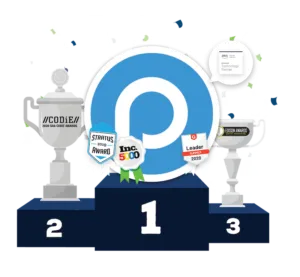5 Examples of Case Management Goals and Objectives
Blog: ProcessMaker Blog
Case management offers a broad range of benefits at the organizational level. These include easier access to information, efficient collaboration, enhanced record keeping and compliance, and providing superior customer care. Yet, when it comes to implementing case management, there can be some confusion over its uses and how to apply it. One of the best ways to understand its potential applications is by looking at some real-world examples of case management uses.
In this article we will briefly explore what case management is and conclude by looking at five examples that will illustrate how you use case management methods and technology to help your organization achieve its goals and objectives.
What is case management?
In the social services or medical fields, defining case management, and its goals and objectives is relatively easy. Cases are tied to patients. The goals and objectives of case management involve treating the patient’s condition. In a business setting, however, cases are not as readily defined. The goals and objectives of case management will vary greatly depending on the problems that the organization is attempting to resolve.
So, what then is a business use case? Basically, whatever an organization wishes to improve. A case could be a specific problem, incident, response, transaction, or any other complex issue. Through case management, an organization simplifies complex problems through streamlined and replicable workflows. These workflows are modeled after the steps of the case management process:
- Screening
- Assessing
- Determining risk
- Planning
- Implementing
- Follow-up
- Evaluating
By following these steps, organizations can boost efficiency while delivering consistent results. Let’s look at five case management examples to get a better idea of how these principles work in business settings.
Case management example #1 – Service requests
Many organizations regularly receive some variation of a service request. Service requests are made by customers or employees to work on or repair some type of asset. These requests present organizations with several challenges. For instance, tracking requests, handling many requests at once, and inefficiencies from working on recurring issues.
Successfully resolving service request cases requires an organization to establish workflows and automating different aspects of the process. This is easily accomplished through case management software. Service request workflows involve a customer or employee making a formal request. Requests are screened and accessed, assigned a level of priority, and sent on for approval. From there, a service desk agent will fulfill the request or reach out to a third-party to schedule service.
The customer service agent or case manager will then follow up with the customer or employee to ensure that the issue has been resolved. If not, further actions are taken until the individual is satisfied and the ticket is closed out. Note that by automating various steps in this process, such as implementing a self-service portal, an organization can significantly reduce the amount of time needed to resolve service requests.
Case management example #2 – Employee onboarding
New employee onboarding is among the more time-consuming HR tasks. Onboarding plays an important role in employee engagement, retention, and productivity. Yet, when an organization leaves this process to chance, key details in the hiring process are missed along the way. Goals and objectives of the onboarding process include collecting important documentation, assigning resources and tools, training, and accounting tasks, among others.
Through case management, an organization can ensure that all onboarding requirements are met. With case management software, an organization can create checklists and workflows, as well as automate important tasks. For instance, onboarding systems can be automated to integrate with contract management. This simplifies record keeping by signing and storing documents electronically and eliminates the need for inefficient processes like manual filing.
With case management, HR staff can follow up with employees to ensure that they are getting acclimated, improving the onboarding experience while boosting new hire retention. Case managers can also review key performance indicators and continually improve the onboarding process.
Case management example # 3 – Claims processing
Processing claims is an important need for many organizations. The process starts with a customer filing a claim. That claim must be screened, accessed, and prioritized. Where a claim is filed under a policy or warranty, the applicable documents must be reviewed, and the item assessed for damage to ensure coverage. If covered payment must be made. If the claim is denied, the appropriate parties must be notified.
The claims process presents screening challenges due to the potential for fraudulent claims, as well as challenges investigating claims due to legal issues. There is also the possibility for inconsistencies in claims processing and poor systems and team integration. The goals and objectives of claims processing case management is to process claims quickly and accurately with as little resources as possible.
With case management software, organizations can automate claims processing. Documents can be gathered and stored electronically. Claims representatives can easily access and share information with customers. Approved claims can be timely paid.
Case management example #4 – Requests and approvals
In many organizations, stakeholders must jump through hoops to get approvals for things like work orders, time off, or paying an invoice. This can lead to bottlenecks in workflows and significantly impact productivity. With case management, requests and approvals are streamlined so that all key stakeholders are informed. Stakeholders can access information and communicate through a single interface. Documents can be signed and stored online.
The case management process for requests and approvals starts with user submission. The request goes to the appropriate stakeholders for review and signature. Employees can follow up with these parties to ensure timely processing of the requests. It is important to regularly evaluate and improve these processes through clearly defined workflows.
For instance, if an employee is requesting a week off from vacation, getting the approval of his or her supervisor and/or HR should be sufficient. There typically is no need to include officers like the CEO or COO in standard requests like these. Tools like a process modeler help organizations to map out their processes to ensure the efficient flow of information and assignment of tasks.
Case management example # 5 – Error messages and bug tracking
Nearly every organization regularly encounters some type of error in how their systems function. These errors must be recorded, investigated, and repaired. Tracking bugs and resolving error messages present a challenge due to a lack of standardized processes. Organizations may lack a system for indexing errors, communicating them to the appropriate stakeholders for testing and resolution, and tracking their resolution. Case management can easily solve these problems.
Case management helps organizations to log and validate errors, assign them to stakeholders, create plans for resolving errors, having the issues tested and repaired, and gathering useful feedback. Nearly all these functions can be automated with case management software. When an error is detected it can automatically be assigned. Once the issue is resolved, stakeholders can be notified of the resolution. Case managers can follow up and analyze data to identify potential improvements to processes.
 About ProcessMaker
About ProcessMaker
Case management has potentially unlimited business uses. Case management presents organizations with a streamlined solution to identify and achieve their goals and objectives. Through case management software like ProcessMaker, organizations can implement industry leading case management practices while boosting efficiency and productivity through automation. Try ProcessMaker today for your case management and automation needs. Schedule a 7 day free trial or download our whitepapers.
The post 5 Examples of Case Management Goals and Objectives appeared first on ProcessMaker.
